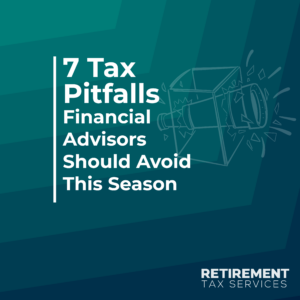Many financial advisors hesitate to provide any client tax planning advice—mainly due to compliance oversight. However, there are still several ways you can provide massive value without having to provide any technical tax advice. In this article, we explore the different tax value-adds advisors can and should be implementing that require no technical tax expertise.
Encouragement, Not Complexity
Great advisors are always looking for more ways to deliver value to their clients. When it comes to taxes, the headlines can be all about complex strategies that promise huge savings over the life of the client. While some of these are great, complexity is NOT the same as value for your clients.
As a great advisor, you should learn about the different strategies that are out there and be comfortable working with your clients to see if they are applicable. But to deliver on the comprehensive financial plan you promise on your website you need to make sure you cover the simple things as well.
Help Instead of Headaches
You also need to go beyond just quantifiable savings and deliver value by making the tax process less painful for your clients. Think about your own tax filing process, if you are a business owner you might be more aware of what your total tax bill for the year was but most people can tell you if they got a refund or had to make a payment, and they can tell you if there were any headaches in the process.
Taxpayers don’t go around talking about how they paid $1,000 less in total tax this year, they will never stop talking about the year their taxes were late because they forgot about a 1099 and the CPA had to go back and adjust their return at the last minute.
5 Simple Ways to Be Your Client’s Tax Planning Hero (Without Providing Tax Advice)
You don’t need to be a CPA to give clients extra value where their taxes are concerned. It’s very possible to do without straying into tax advice or preparation. These sound suggestions may even deepen their trust in you as an advisor.
Provide a year-end ‘1099’ letter.
You have a list of your clients’ accounts already and should be aware of, and tracking any taxable transactions. Build a process for your team to summarize this information in a letter you can send to all of your clients so there are no questions or surprises about what tax forms they should be expecting. Summarize this in a way that the client can take with them to their tax preparer and encourage them to do just that. You’ll win with the client and you’ll win with their tax preparer because so few advisors do this.
As with so many things, don’t confuse quantity with value. This should be one or two pages at most!
Provide a summary letter of any decisions you made with your client this year that might have a tax impact.
Similar to the first idea this should be a 1 or 2-page document that your client can take with them to their tax preparer. These are just the highlights and the important facts for a tax preparer to know before they start the return. You can even address it to the tax preparer and offer to discuss why your client decided on these strategies.
This is a fantastic way to get tax preparers on your team and not put yourself in a situation where the tax preparer is backing the bus right over you in front of your client. Tax preparers have endless bad experiences with financial advisors because the tax preparer is often the one asking the client to write the check for taxes at the end of the year. The upsides of a good tax strategy are quickly forgotten by the client if 6 months later during tax time the CPA is telling the client how your client tax planning strategy is the reason they are cutting a check.
Encourage clients to make estimated payments with the final dollar corresponding with the quarterly payment number (e.g. $10,001 for Q1, $10,002 for Q2).
This is a great recommendation because WHEN, not if, the IRS screws up a payment there is no confusion about which one it was. If they make the same payment all four quarters the client is left wondering which payment needs to be replaced. I know several advisors who do this with their clients, it’s such a simple conversation and clients love it.
Show clients how to make estimated payments online.
This will simplify the process for the client. It will also avoid the risk of the IRS losing checks (which does happen).
Do basic error checking on the client’s tax return of the non-tax-related information.
Everyone makes mistakes. I recently talked to an advisor who had a client that started receiving nastygrams (audit letters) from the IRS because their social security number was off by one digit on the tax return. Ultimately this wasn’t complicated to resolve but it was a painful experience for the client that could have been avoided. It is completely irrelevant that you didn’t sign off on the tax return, this isn’t about fault, this is about you adding value to your clients.
This is something you can easily have your team do for you once you’ve received all your client’s tax returns. You already have their personal information in your CRM because of the other work you do with them. Take the time to double-check their name, address, social security number, etc., and make sure you let the client know you did it whether you find mistakes or not.
Not a CPA? Not an excuse
Some advisors want to leave everything tax-related to the tax preparers, these advisors are not providing massive value to their clients. I have personally talked to advisors who in the same sentence will tell me they aren’t allowed to do tax planning but that they regularly help their clients with Roth conversions. So many things an advisor helps their clients do have tax implications. Great advisors know that, and use it to deliver massive value to their clients. If your client works with a CPA or tax preparer this is a great opportunity to build a relationship with them at the same time. Good tax preparers are asking about these kinds of things as well but will have several hundred returns they work on in a year; they aren’t going to know your client as well as you can.
Before you start a Roth conversion, have the client, or work with the client, to have a conversation with their tax preparer about your proposed approach. Proactively going to the tax preparer will set you apart from the abundance of advisors who make changes the preparer only finds out about after they have happened and often are the ones left correcting any mistakes.
3 Action Items To Make You A Tax Hero To Clients
Here is what every great advisor should be doing related to this topic:
- Get tax returns for every client every year.
- Build a process for your team to generate a 1099 letter and an annual tax summary letter your clients can take with them to the tax preparer.
- Pick at least one of your meetings with your client each year and add these suggestions to your agenda. If they aren’t relevant in a particular year it will only take a minute and your client KNOWS that you are considering these things and taking care of them. Never assume the client knows what you are doing when they aren’t around. If you don’t let them know it happened, you get zero credit for doing it.
Remember to tip your server, not the IRS!





